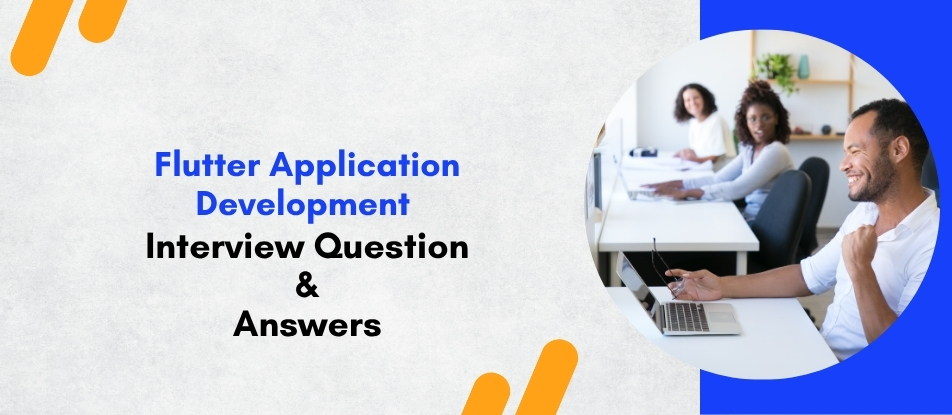
The Flutter Application Development course offers comprehensive training to build beautiful, natively compiled mobile apps for Android and iOS using a single codebase. Learners explore Dart programming, UI components, state management, navigation, and backend integration. Ideal for aspiring and experienced developers, the course combines theory with hands-on projects to develop responsive and scalable apps. By course end, participants are equipped to confidently design, develop, and deploy Flutter applications.
Flutter Application Development Training Interview Questions Answers - For Intermediate
1. What are isolates in Dart, and why are they important for Flutter performance?
Isolates are independent workers that run on separate memory heaps, allowing Dart to perform true parallel computation without shared state. In Flutter they are useful for intensive tasks such as parsing large JSON files or performing cryptographic operations, because heavy work can be moved off the main isolate that drives the UI. This keeps animations smooth and prevents jank by ensuring the rendering thread remains unblocked.
2. How does hot restart differ from hot reload in Flutter development?
Hot reload injects updated source files into the running application, preserving the current state and quickly reflecting UI changes. Hot restart recompiles the entire app and restarts the Dart VM, so all application state is lost and the app starts from its initial route. Developers use hot reload for rapid visual tweaks, whereas hot restart is helpful when global variables, main-level initializations, or static resources change.
3. Explain the difference between implicit and explicit animations in Flutter.
Implicit animations, provided by widgets such as AnimatedContainer or AnimatedOpacity, automatically interpolate between old and new values whenever a property changes, requiring minimal configuration. Explicit animations, using controllers and animation classes, offer granular control over timing, curves, and animation life-cycle events. Implicit animations are simpler for straightforward transitions, while explicit animations are preferred for complex, choreographed sequences.
4. Describe the main layers of Flutter’s architecture and their roles.
Flutter is organized into the Framework, Engine, and Embedder layers. The Framework, written in Dart, includes the widget, rendering, and animation libraries that developers use directly. The Engine, largely in C++, houses the Skia graphics library and handles rendering, text layout, and low-level primitives. The Embedder adapts the engine to the underlying platform—Android, iOS, web, or desktop—handling window creation, input, and system-level services.
5. What is the distinction between a Flutter package and a plugin?
A package is a reusable collection of Dart code, assets, or resources that runs purely within Flutter’s managed environment. A plugin extends that concept by adding native platform code, allowing Dart to communicate with Android, iOS, or desktop APIs through platform channels. Choose a package when functionality can be achieved entirely in Dart; use a plugin when you need sensors, device storage, or other native capabilities.
6. How does state restoration work in Flutter, and when should you implement it?
State restoration lets an app return to the same visual state after the operating system kills and later resumes it. Flutter offers a restoration framework that stores widget state data in a restoration bucket, which is serialized and later revived. Implement state restoration for apps that handle critical user workflows—such as form entry or multi-step wizards—on platforms where the OS may reclaim resources aggressively.
7. What are platform channels, and how do they facilitate native functionality in Flutter?
Platform channels provide a bidirectional messaging system between Dart and the host platform using a standardized message codec. They enable Flutter apps to invoke native APIs or third-party SDKs not available in Dart. Messages are serialized, passed to native code, executed, and results are returned to Dart. This mechanism keeps the Flutter framework lightweight while allowing broad platform integration.
8. Differentiate between a widget, an element, and a render object in Flutter.
A widget is an immutable configuration describing part of the UI. An element acts as the bridge between a widget and the underlying render object, holding the widget’s runtime state in the widget tree. A render object is responsible for layout, painting, and hit-testing. Understanding these layers helps diagnose issues such as unnecessary rebuilds or layout passes that can impact performance.
9. How does Dart’s null safety benefit Flutter development?
Null safety distinguishes nullable from non-nullable types at compile time, reducing runtime null-reference errors. It forces developers to handle potentially absent values explicitly, improving code robustness. In Flutter this leads to safer widget compositions, clearer APIs, and fewer crashes caused by uninitialized variables or asynchronous calls that return null unexpectedly.
10. What considerations go into internationalizing and localizing a Flutter app?
Internationalization involves extracting translatable text, dates, and number formats into resource files, while localization provides region-specific translations and formatting. Flutter supports this through the intl package and generated arb files. Key steps include defining supported locales, loading appropriate translations at runtime, and ensuring widgets such as Text automatically use locale-aware formatting. Proper planning helps create a seamless experience for global audiences.
11. Describe the three primary testing strategies available in Flutter and their scopes.
Unit tests validate individual functions or classes in isolation, ensuring business logic correctness. Widget tests run within a simulated Flutter environment, verifying that visual components behave as expected given specific inputs. Integration tests launch the app on a real or virtual device, interacting with UI elements from end to end. A balanced testing pyramid—with many unit tests, fewer widget tests, and essential integration tests—offers comprehensive quality assurance.
12. How do you capture and handle asynchronous errors in Flutter applications?
Asynchronous errors can be caught at the point of Future completion with catchError, through try–await–catch blocks, or by listening to Stream error events. Flutter also provides a global error handler via FlutterError.onError for framework errors and runZonedGuarded for uncaught asynchronous exceptions. Logging these errors and reporting them to monitoring services helps diagnose issues that may not surface during development.
13. What strategies help manage image caching and memory usage in Flutter?
Flutter caches images in memory to improve scroll performance, but large or numerous images can exhaust resources. Developers can limit cache size with the PaintingBinding imageCache or precache images selectively. Using lower-resolution thumbnails, lazy loading with ListView builders, and compressed asset formats reduces memory footprints. Properly disposing of image providers when no longer needed helps prevent leaks.
14. How does Flutter support accessibility, and which practices should developers follow?
Flutter’s semantics tree conveys UI descriptions to assistive technologies like screen readers. Developers should supply meaningful labels, hints, and roles via semantics properties and ensure touch targets meet size guidelines. Using colorblind-friendly palettes, high-contrast themes, and logical focus order enhances usability. Automated tools in the Flutter inspector help audit and improve accessibility compliance.
15. Explain the compilation modes available in Flutter and their typical use cases.
Flutter offers three compilation modes. Debug mode compiles code with just-in-time execution, enabling hot reload and extensive logging for development. Profile mode removes most debugging overhead while preserving instrumentation to analyze performance on real devices. Release mode performs ahead-of-time compilation and tree shaking, producing optimized binaries for distribution. Selecting the appropriate mode ensures efficient iteration, profiling, and deployment.
Flutter Application Development Training Interview Questions Answers - For Advanced
1. What are the challenges of managing app state in Flutter, and how do advanced state management solutions help?
Managing app state becomes complex when multiple widgets across different parts of the app depend on shared data. Challenges include unnecessary widget rebuilds, tightly coupled logic, and difficulties in maintaining scalability. Advanced state management solutions like Bloc, Riverpod, or Redux help decouple business logic from UI, enforce predictable state transitions, and make testing easier. These tools promote unidirectional data flow, centralize state, and offer mechanisms like streams, providers, or immutable objects to manage and react to changes in a controlled and scalable manner.
2. How does Flutter handle asynchronous UI updates, and what pitfalls should developers avoid?
Flutter manages asynchronous updates using Futures and Streams, allowing non-blocking UI operations like data fetching or animations. However, developers must be cautious to update the UI only when the widget is mounted to avoid exceptions. Common pitfalls include memory leaks from unclosed streams, race conditions between asynchronous calls, and improper state updates outside of the UI thread. To ensure smooth updates, developers should manage asynchronous lifecycle events properly and isolate async logic from build methods.
3. Describe the use of themes in Flutter and their role in building maintainable UIs.
Themes in Flutter provide a centralized way to define colors, fonts, button styles, and other visual attributes. This ensures consistency across the app and simplifies future UI changes. Theming is especially beneficial for maintaining brand identity or implementing light/dark modes. By defining themes globally and locally, developers can create layered styling systems that are reusable and responsive. Proper theme usage reduces redundancy, improves scalability, and enhances collaboration across design and development teams.
4. What are the key considerations when building a Flutter app for both mobile and web platforms?
Developing a Flutter app for both mobile and web requires attention to layout, performance, and platform-specific behavior. Web apps must account for browser limitations, network latency, and responsiveness to different screen sizes. Certain mobile APIs like camera access or geolocation may not behave the same on the web, so conditional logic or alternative implementations are needed. Also, web performance optimization strategies such as reducing asset sizes, using lazy loading, and minimizing DOM updates become crucial for a smooth experience.
5. How do you profile and debug performance issues in Flutter applications?
Profiling Flutter apps involves analyzing rendering performance, memory usage, and UI build times using tools like Flutter DevTools. Frame charts, timeline views, and rebuild indicators help identify performance bottlenecks. Developers should look for excessive widget rebuilds, overdraw, and long frame durations. Debugging involves checking logs, reviewing widget trees, and simulating different device environments. Efficient use of profiling tools enables data-driven decisions to optimize user experience and app responsiveness.
6. What are dependency injection (DI) techniques in Flutter, and why are they useful in large applications?
Dependency injection simplifies the management of shared services like network clients, databases, or state managers. It decouples class dependencies, improves testability, and facilitates modular design. In Flutter, DI is commonly implemented through packages that provide context-based lookup mechanisms. In large applications, DI enables clear separation of concerns, promotes reusable logic, and simplifies refactoring by making dependencies easy to replace or mock during unit testing.
7. What is the impact of layout inflation and overdraw on Flutter app performance?
While Flutter doesn’t rely on layout inflation in the same way as native platforms, complex widget trees can mimic similar performance issues. Overdraw occurs when multiple layers paint over the same pixel, increasing GPU workload. Deep nesting of widgets or excessive opacity layers can lead to increased layout times and sluggish performance. To mitigate this, developers can simplify widget hierarchies, use composite layers judiciously, and apply techniques like clipping and repaint boundaries to optimize rendering.
8. How does internationalization affect Flutter architecture and testing?
Internationalization requires the app to support multiple locales and dynamically load translated content, date formats, and text directions. Architecturally, it demands separating UI from text resources, supporting right-to-left layouts, and managing pluralization and formatting differences. Testing becomes more complex, requiring verification across multiple locales and scripts. Tools and automated test cases must validate not just correctness, but also UI adaptability to longer or non-Latin strings.
9. What are the best practices for designing scalable and maintainable navigation in Flutter?
Scalable navigation requires clear route definitions, consistent naming conventions, and support for nested and dynamic routing. Best practices include separating navigation logic from UI, using typed arguments, and leveraging state restoration to maintain navigation history. Modular navigation setups—where each feature has its own navigator—improve maintainability. Declarative routing libraries also simplify complex scenarios like deep linking, authentication guards, and URL syncing.
10. How would you implement analytics in a Flutter app while respecting user privacy and GDPR compliance?
Implementing analytics starts with defining meaningful events and user properties. Integration with analytics platforms must support user consent, anonymization, and opt-out capabilities. For GDPR compliance, users must be informed and allowed to revoke tracking permissions. Data collection should be minimized to essentials, with clear documentation and privacy policies. Developers must ensure that analytics events are decoupled from sensitive data and properly managed in both foreground and background states.
11. What is widget testing in Flutter, and how does it differ from unit and integration testing?
Widget testing simulates user interactions and rendering logic in a controlled Flutter environment without relying on physical devices or emulators. Unlike unit testing, which focuses on isolated logic, widget tests verify how widgets behave when built, interacted with, and updated. They differ from integration tests by offering faster execution and narrower scope. Widget testing helps ensure UI stability and behavior correctness, especially during layout or logic changes.
12. How does hot reload improve developer productivity, and when should it be avoided?
Hot reload dramatically improves developer productivity by allowing real-time UI updates without restarting the app. It preserves the widget state, enabling fast iteration and visual debugging. However, it should be avoided when modifying stateful logic in constructors, dependency injection, or initialization routines, as these changes may not be fully reflected. In such cases, a full restart ensures application stability and consistency.
13. Describe how Flutter supports accessibility and inclusive design practices.
Flutter supports accessibility through semantic annotations, screen reader compatibility, focus traversal, and adaptive text scaling. Developers can use semantic widgets and metadata to describe UI elements for assistive technologies. Inclusive design also involves supporting high contrast themes, sufficient color contrast, large touch targets, and dynamic font sizing. Accessibility should be planned from the beginning to ensure that all users, including those with disabilities, can interact with the app effectively.
14. What challenges do developers face when handling background tasks in Flutter, and how are they addressed?
Flutter's UI runs on a single thread, so background operations like file downloads or location tracking require special handling. On Android and iOS, background execution must comply with platform-specific constraints. Developers use platform-specific services, isolate-based background processing, or third-party plugins to manage tasks like notifications or data sync. Challenges include resource constraints, permissions, battery optimization policies, and managing app state transitions, especially when the app is suspended or killed.
15. How do you ensure cross-platform consistency in UI and behavior in a Flutter app?
Consistency is achieved through custom themes, centralized style management, and avoiding reliance on platform-specific widgets unless necessary. Using the same layout structure and design language across platforms helps maintain visual parity. Developers must also test behavior across platforms to identify inconsistencies in gestures, scrolling, or animations. Conditional logic can be applied to address specific platform constraints while maintaining a unified experience where possible.
Course Schedule
| Nov, 2025 | Weekdays | Mon-Fri | Enquire Now |
| Weekend | Sat-Sun | Enquire Now | |
| Dec, 2025 | Weekdays | Mon-Fri | Enquire Now |
| Weekend | Sat-Sun | Enquire Now |
Related Courses
Related Articles
Related Interview
Related FAQ's
- Instructor-led Live Online Interactive Training
- Project Based Customized Learning
- Fast Track Training Program
- Self-paced learning
- In one-on-one training, you have the flexibility to choose the days, timings, and duration according to your preferences.
- We create a personalized training calendar based on your chosen schedule.
- Complete Live Online Interactive Training of the Course
- After Training Recorded Videos
- Session-wise Learning Material and notes for lifetime
- Practical & Assignments exercises
- Global Course Completion Certificate
- 24x7 after Training Support













 Join our Live Instructor-Led online classes delivered by industry experts
Join our Live Instructor-Led online classes delivered by industry experts